catalogue
1. Spring boot simplifies Mybatis
1.1.4 description of main startup exceptions
1.1.5 modify YML configuration file and pojo class
1.1.6 submit Mapper interface to container management
2.1 query data according to ID
2.1.2 editing Mapper interface
2.1.3 edit UserMapper.xml mapping file
2.3.3 edit UserMapper.xml mapping file
2.4 query users with age > 18 and age < 100
2.4.3 editing Mapper interface
2.4.4 editing xml Mapping Files
2.5 realize data encapsulation with annotation @ Param
2.5.2 editing interface documents
2.5.3 editing xml Mapping Files
2.6.3 editing interface method
2.6.4 editing xml Mapping Files
2.8 set parameter writing in mybatis
2.8.3 editing Mapper interface
2.8.4 editing Mapper mapping file
2.9.2 editing interface method
2.9.3 editing xml Mapping Files
1. Spring boot simplifies Mybatis
1.1 project integration
1.1.1 create project
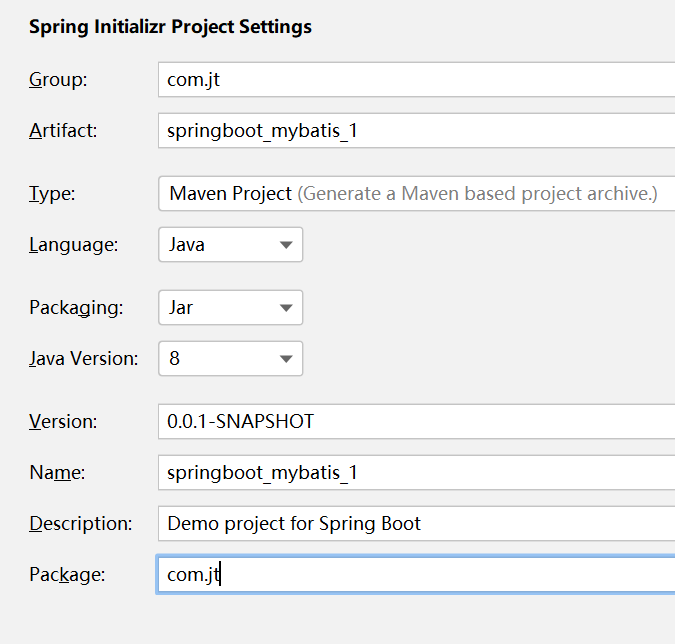
1.1.2 import jar package
Note: add jar package file in pom.xml file
<!--mybatis Dependent package-->
<dependency>
<groupId>org.mybatis.spring.boot</groupId>
<artifactId>mybatis-spring-boot-starter</artifactId>
<version>2.2.0</version>
</dependency>
<!--jdbc Dependent package-->
<dependency>
<groupId>mysql</groupId>
<artifactId>mysql-connector-java</artifactId>
</dependency>
<!--add to lombok My bag-->
<dependency>
<groupId>org.projectlombok</groupId>
<artifactId>lombok</artifactId>
</dependency>
1.1.3 delete redundant files
Note: delete the redundant files and keep the files in the figure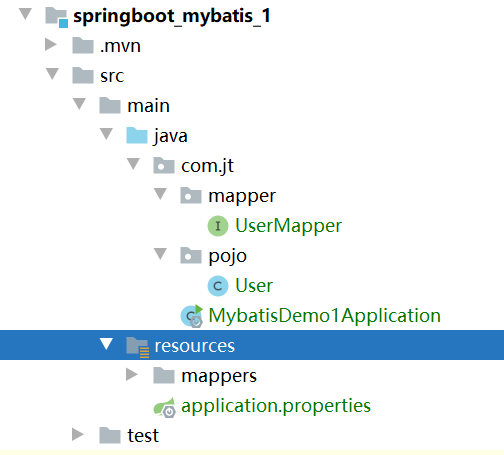
2. Modify the profile name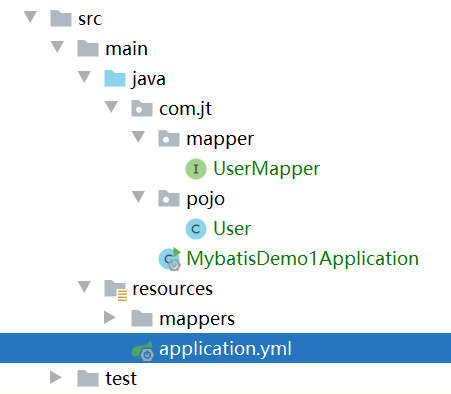
1.1.4 description of main startup exceptions
Tip: "out of the box" principle
Error message: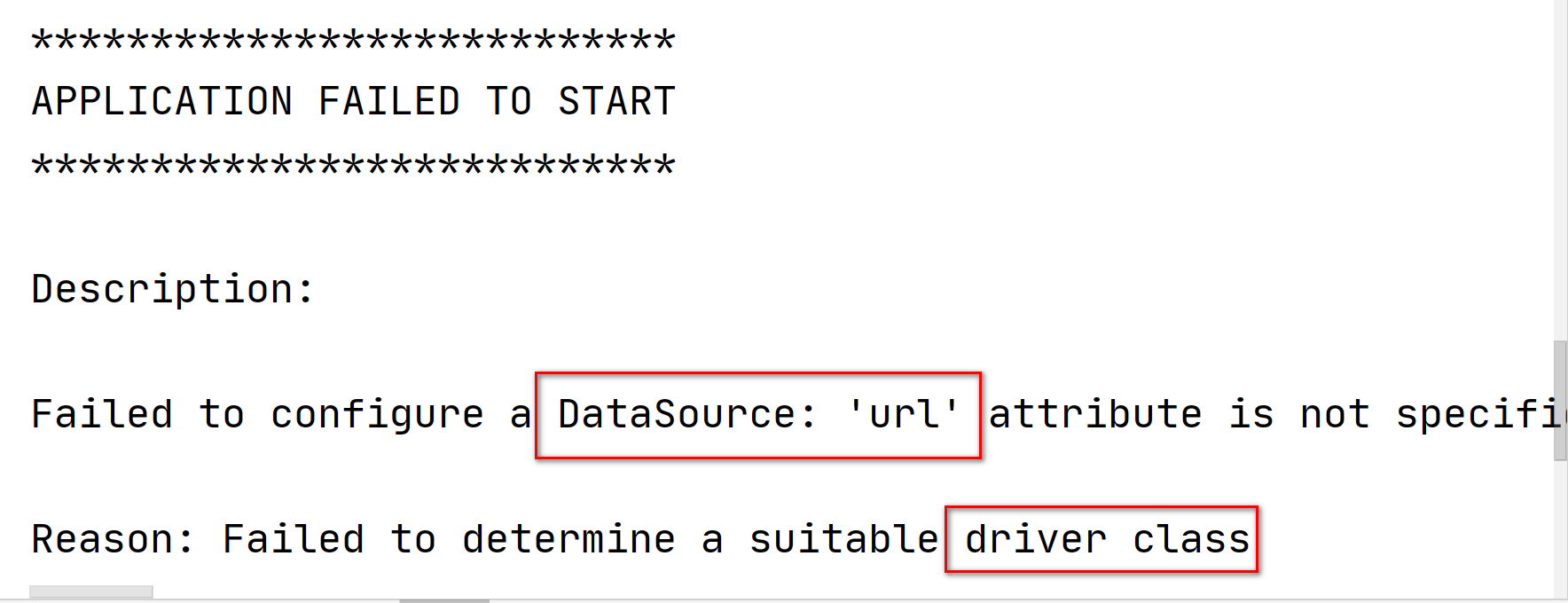
Description of error reporting principle:
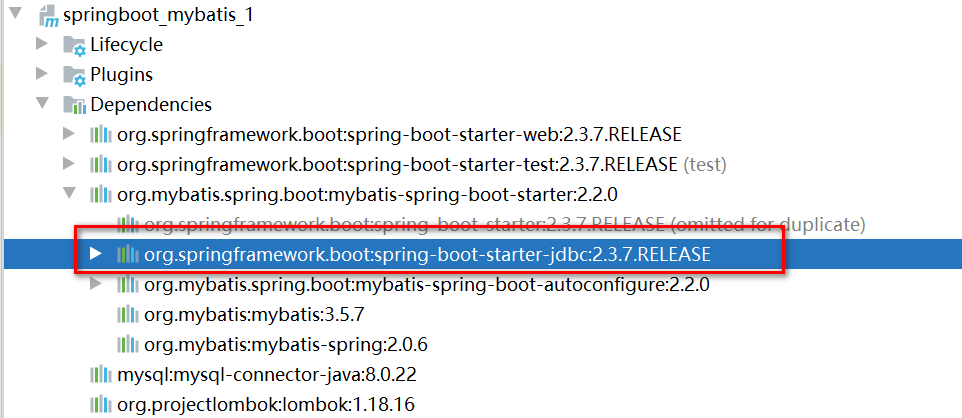
Mybatis relies on the JDBC jar package. However, the jar package file is a startup item. When the main startup class runs, the main startup item starts to be loaded. However, JDBC needs to link the database. Therefore, there must be relevant configuration information. However, there is no data source configuration in the YML file at this time. Therefore, an error is reported
1.1.5 modify YML configuration file and pojo class
YML profile
#1. Pay attention to indent when configuring the port number!!!!!
server:
port: 8090
#2. Configure data source
spring:
datasource:
driver-class-name: com.mysql.cj.jdbc.Driver
url: jdbc:mysql://127.0.0.1:3306/jt?serverTimezone=GMT%2B8&useUnicode=true&characterEncoding=utf8&autoReconnect=true&allowMultiQueries=true
username: root
password: root
mybatis:
type-aliases-package: com.jt.pojo
#Load all mapping files
mapper-locations: classpath:/mappers/*.xml
#Turn on hump mapping
configuration:
map-underscore-to-camel-case: true
pojo class
package com.jt.pojo;
import lombok.AllArgsConstructor;
import lombok.Data;
import lombok.NoArgsConstructor;
import lombok.experimental.Accessors;
@Data//Auto generate get sat method
@Accessors(chain = true)//Rewrite the set method to realize chain loading
@NoArgsConstructor//Nonparametric structure
@AllArgsConstructor//Fully parametric structure
public class User {
private Integer id;
private String name;
private Integer age;
private String sex;
}
1.1.6 submit Mapper interface to container management
package com.jt.mapper;
import com.jt.pojo.User;
import org.apache.ibatis.annotations.Mapper;
import java.util.List;
@Mapper //Give the interface to the Spring container to manage map < usermapper, JDK proxy object >
public interface UserMapper {
//Specify interface method query demo_ All data of user
List<User> findAll();
}
1.1.7 edit test class
package com.jt;
import com.jt.mapper.UserMapper;
import com.jt.pojo.User;
import org.junit.jupiter.api.Test;
import org.springframework.beans.factory.annotation.Autowired;
import org.springframework.boot.test.context.SpringBootTest;
import java.util.List;
@SpringBootTest
public class TestMybatis {
@Autowired
private UserMapper userMapper;
@Test
public void testDemo1(){
List<User> userList = userMapper.findAll();
System.out.println(userList);
}
}

2. Basic usage of mybatis
2.1 query data according to ID
2.1.1 edit test method
@Test
public void testFindUserById(){
int id = 1;
User user = userMapper.findUserById(id);
System.out.println(user);
}
2.1.2 editing Mapper interface
@Mapper //Give the interface to the Spring container to manage map < usermapper, JDK proxy object >
public interface UserMapper {
//Specify interface method query demo_ All data of user
List<User> findAll();
//Query database by ID
User findUserById(int id);
}
2.1.3 edit UserMapper.xml mapping file
<!-- according to ID query data base
Dynamic value: #{key}
-->
<select id="findUserById" resultType="com.jt.pojo.User">
select * from demo_user where id = #{id}
</select>
2.2 Sql statement printing
Description: add log operation in YML file
#1. Pay attention to indent when configuring the port number!!!!!
server:
port: 8090
#2. Configure data source
spring:
datasource:
driver-class-name: com.mysql.cj.jdbc.Driver
url: jdbc:mysql://127.0.0.1:3306/jt?serverTimezone=GMT%2B8&useUnicode=true&characterEncoding=utf8&autoReconnect=true&allowMultiQueries=true
username: root
#The yml file 0 does not parse. If the letter begins with 0, the quotation marks are wrapped
#password: "0123456"
password: root
#3. Configure Mybatis
mybatis:
type-aliases-package: com.jt.pojo
#Load all mapping files
mapper-locations: classpath:/mappers/*.xml
#Turn on hump mapping
configuration:
map-underscore-to-camel-case: true
#4. Print the Sql log under Sql com.jt.mapper
logging:
level:
com.jt.mapper: debug

2.3 query by name and age
2.3.1 edit test class
/**
* Knowledge points:
* 1.If multiple parameters are passed, it is generally encapsulated by object
*/
@Test
public void testFindByNA(){
String name = "Sun Shangxiang";
int age = 18;
User user = new User();
user.setName(name).setAge(age);
List<User> userList = userMapper.findUserByNA(user);
System.out.println(userList);
}
2.3.2 editing UserMapper
@Mapper //Give the interface to the Spring container to manage map < usermapper, JDK proxy object >
public interface UserMapper {
//Specify interface method query demo_ All data of user
List<User> findAll();
//Query database by ID
User findUserById(int id);
List<User> findUserByNA(User user);
}
2.3.3 edit UserMapper.xml mapping file
<!-- according to name and age Query data
Knowledge points: Alias package
Specify the package path in the configuration file: The splicing of packet paths can be realized automatically
resultType rule:
1. First, match the package according to the alias.set up..
2. If the match is not successful,Match by path.
Rules for parameter passing:
1. If it is a single parameter,Then use#The value of the parameter obtained by {key}
2. If it is an object parameter,Then use#{property} gets the property value
-->
<select id="findUserByNA" resultType="User">
select * from demo_user where
name = #{name} and age = #{age}
</select>
2.4 query users with age > 18 and age < 100
2.4.1 Sql statement
select * from demo_user where age>18 and age <100
2.4.2 edit test class
/**
* Knowledge point 3:
* Note: if multiple parameters are inconvenient to be encapsulated by User object, the universal set Map should be used
*/
@Test
public void testFindByAge(){
int minAge = 18;
int maxAge = 100;
Map<String,Integer> map = new HashMap<>();
map.put("minAge",minAge);
map.put("maxAge",maxAge);
List<User> userList = userMapper.findUserByAge(map);
System.out.println(userList);
}
2.4.3 editing Mapper interface
@Mapper //Give the interface to the Spring container to manage map < usermapper, JDK proxy object >
public interface UserMapper {
//Specify interface method query demo_ All data of user
List<User> findAll();
//Query database by ID
User findUserById(int id);
List<User> findUserByNA(User user);
//Habit: there is only one parameter
List<User> findUserByAge(Map<String, Integer> map);
}
2.4.4 editing xml Mapping Files
<!--
Query data by age
grammar: If the parameter passed is Map, Then use#{key}
xml Translation character:
1. > >
2. < <
3. & &
-->
<select id="findUserByAge" resultType="User">
select * from demo_user where age > #{minAge}
and age < #{maxAge}
</select>
2.4.5 escape label
<!--
Query data by age
grammar: If the parameter passed is Map, Then use#{key}
xml Translation character:
1. > >
2. < <
3. & &
4. Universal translation character
<![CDATA[ Transfer content ]]>
-->
<select id="findUserByAge" resultType="User">
<![CDATA[
select * from demo_user
where age > #{minAge} and age < #{maxAge}
]]>
</select>
2.5 realize data encapsulation with annotation @ Param
2.5.1 edit test class
/**
* Knowledge point 4:
* Data encapsulation using annotations
*/
@Test
public void testFindByAge2(){
int minAge = 18;
int maxAge = 100;
List<User> userList = userMapper.findUserByAge2(minAge,maxAge);
System.out.println(userList);
}
2.5.2 editing interface documents
//Principle: Mybatis only supports single value reference and encapsulates multiple values into single values
//Comments: @ param ("key") int minage (value)
// Function: encapsulate data as Map
List<User> findUserByAge2(@Param("minAge") int minAge, @Param("maxAge") int maxAge);
2.5.3 editing xml Mapping Files
<select id="findUserByAge2" resultType="User">
<![CDATA[
select * from demo_user
where age > #{minAge} and age < #{maxAge}
]]>
</select>
2.6 fuzzy query
2.6.1 business requirements
Query the user whose name field contains "Jun"
Sql statement:
SELECT * FROM demo_user WHERE NAME LIKE "%King%"
2.6.2 edit test method
/**
* Knowledge point 5:
* Data encapsulation using annotations
*/
@Test
public void testFindUserByLike(){
String name = "%" + "King" + "%";
List<User> userList = userMapper.findUserByLike(name);
System.out.println(userList);
}
2.6.3 editing interface method
List<User> findUserByLike(String name);
2.6.4 editing xml Mapping Files
<!--Fuzzy queries pay special attention to the case of table names!!!!!
windows In the system: Case insensitive
Linux In the system: Case sensitive.
-->
<select id="findUserByLike" resultType="User">
SELECT * FROM demo_user WHERE NAME LIKE #{name}
</select>
Mode 2: xml Profile dynamic splicing%
<!--Fuzzy queries pay special attention to the case of table names!!!!!
windows In the system: Case insensitive
Linux In the system: Case sensitive.
grammar: "%" In this way
-->
<select id="findUserByLike" resultType="User">
SELECT * FROM demo_user WHERE NAME LIKE "%"#{name}"%"
</select>
2.7 Sql tag usage
2.7.1 business requirements
Note: duplicate data often appears in Sql statements. If the repeated content is handwritten each time, the development efficiency is low
Optimization: extract public Sql
Advantage: Sql tags can save code
Disadvantages: poor readability. If it is an associated operation, it depends on the situation
2.7.2 Sql tag usage
<!--Fuzzy queries pay special attention to the case of table names!!!!!
windows In the system: Case insensitive
Linux In the system: Case sensitive.
grammar: "%" In this way
-->
<select id="findUserByLike" resultType="User">
SELECT <include refid="tableColumn"/> FROM demo_user WHERE NAME LIKE "%"#{name}"%"
</select>
<!--Sql label: Extract public Sql sentence -->
<sql id="tableColumn">
id,name,age,sex
</sql>
2.8 set parameter writing in mybatis
2.8.1 business requirements
Query data with id=1,2,3,5,7
select * from demo_user where id in (1,2,3,5,7........)
2.8.2 edit test class
//Front end: URL?id=1,2,3,4,5. After obtaining, it is generally received by array
@Test
public void testFindListByIn(){
int[] array = {1,2,3,5,7};
List<User> userList = userMapper.findListByIn(array);
System.out.println(userList);
}
2.8.3 editing Mapper interface
List<User> findListByIn(int[] array);
2.8.4 editing Mapper mapping file
<!--
about Mybatis Traversal of
foreach:
1. collection Collection to traverse
1.1 array keyword: array/list
1.2 list Set keyword: list/array
1.3 Map<key,array/list> keyword:key
2. open/close The beginning and end of the loop body can be written outside the loop
3. item Variable name of the current traversal data
4. separator Separator
-->
<select id="findListByIn" resultType="User">
select * from demo_user where id in (
<foreach collection="array" item="id" separator=",">
#{id}
</foreach>
)
</select>
2.9 user addition
2.9.1 edit test method
@Test
public void testInsertUser(){
User user = new User();
user.setName("Zhang San").setAge(18).setSex("male");
userMapper.saveUser(user);
System.out.println("Successfully added!!!!");
}
2.9.2 editing interface method
void saveUser(User user);
2.9.3 editing xml Mapping Files
<insert id="saveUser">
insert into demo_user(id,name,age,sex)
value (null, #{name},#{age},#{sex})
</insert>